2 中国科学院青藏高原研究所, 大陆碰撞与高原隆升重点实验室, 北京 100101;
3 中国科学院大学, 北京 100049)
西宁盆地地处青藏高原东北部,属西风区与东亚季风区的转换地带。西风区内广大的亚洲干旱化内陆地区对全球气候变化影响巨大,然而,包括西宁盆地在内,古气候演化历史及其与西风、高原隆升和全球温度变化的关系仍然不太确定[1~9]。值得注意的是,前人的研究都是通过地球化学、矿物学、孢粉学和岩石学等方法来获得西宁盆地新生代以来的“早渐新世冰盖增大事件”(Oi-1变冷事件,Oi-1 Glaciation)、中新世“Mi-1变冷事件(Mi-1 Glaciation)”以及“早始新世气候最适宜期”(Early Eocene Climatic Optimum, 简称EECO)、“晚渐新世增温事件(Late Oligocene Warming)”和“中中新世气候适宜期(Mid-Miocene Climatic Optimum,简称MMCO)”[10~15]。近年来兴起的微生物细胞膜脂的生物标志化合物甘油二烷基甘油四醚(Glycerol Dialkyl Glycerol Tetraethers,简称GDGTs)指标,常见的有细菌支链GDGTs(branched GDGTs,简称bGDGTs)和古菌类异戊二烯GDGTs(isoprenoid GDGTs,简称iGDGTs)等,因其对环境因子的灵敏响应而受到广泛的重视[16~18]。其中,bGDGTs分布对温度的响应,为陆地古温度重建提供了重要的代用指标[19],诸如CBT′、Ri/b(the ratio of isoprenoid vs. branched GDGTs)等指标也具备古水文古环境恢复的应用潜力[20]。对西宁盆地沉积物中GDGTs分布和指标的研究,有助于为我们理解该地乃至青藏高原东北部的古环境变化特征及其驱动机制提供新的材料和证据。
青藏高原东北部因其特殊的干旱环境成为GDGTs代用指标研究的天然实验场,研究者已对橡皮山、青海湖及其周缘和茶卡盐湖等区域的土壤和湖泊表层沉积物进行了GDGTs现代分布及其指标的环境响应研究[21~28]。然而,在较老地质历史时期(如中新世、渐新世等),GDGTs相关代用指标是否仍能有效记录古环境信息仍需要评估。目前青藏高原较老地层GDGTs研究,仅见零星报道,如:Xie等[29]在札达盆地利用Ri/b记录的干旱信号研究青藏高原在该时段的构造抬升活动;DeCelles等[30]在凯拉斯盆地综合使用了bGDGTs的温度指标MBT/CBT(甲基化指数(Methylation index of Branched Tetraethers,简称MBT)与环化指数(Cyclisation ratio of Branched Tetraethers,简称CBT)之比)及古菌GDGTs的温度指标TEX86,发现在26~21 Ma期间该区域仍处在较低海拔环境。并且近年来,GDGTs的新结构(6甲基异构体等)、新指标(MATmr、CBT′等)不断出现,对已有指标进行了大量校正工作[20, 22],这些新指标和新结果在青藏高原的应用仍需要进一步展开。
本研究在青藏高原东北部西宁盆地关家山剖面(GJS)中中新世连续地层中开展GDGTs分布和指标研究,试图利用GDGTs重建的古温度、古pH值和古水文记录等,探讨西宁盆地在全球变化背景下的区域环境变化特征及驱动机制,并评估GDGTs指标在该区域较老地层中的应用潜力。
1 研究区概况和实验方法 1.1 研究区概况西宁盆地位于西北内陆干旱区、东部季风区与青藏高原高寒区交汇带(图 1),南以拉脊山为屏障,北侧为达坂山,西部超覆于湟源北山之上,东延入甘肃境内。其盆地面积为10568 km2,海拔为1560~4000 m。地形主要为黄土高原被沟壑切割成中高-低山、丘陵和河川阶地。它属中干旱高原大陆性气候,年平均气温7.9~8.1℃,最高气温可达35℃(7月下旬),最低气温为-23℃(1月下旬),年降水量350~650 mm[31~32]。
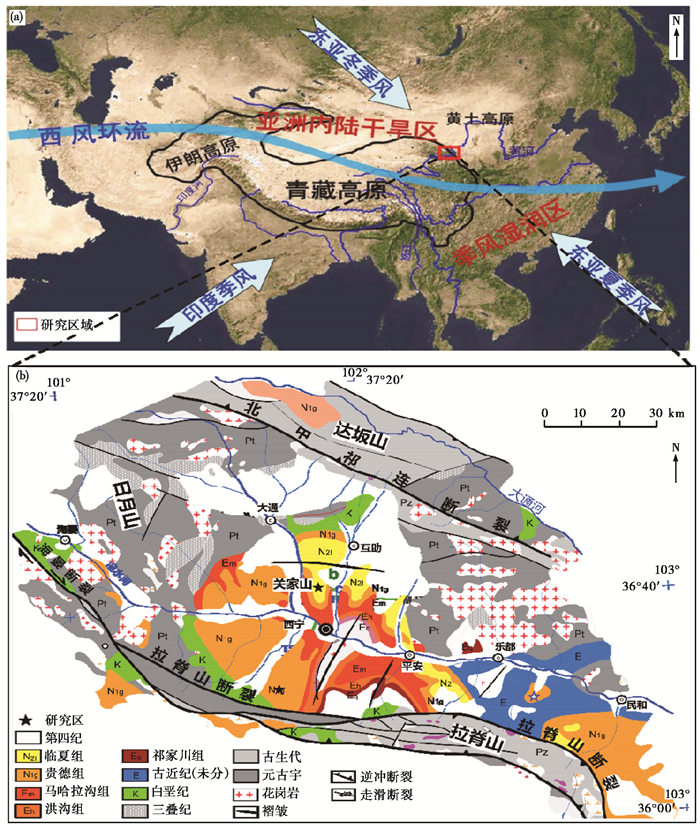
|
图 1 (a) 西宁盆地地理位置与所处的气候区(亚洲内陆干旱区与东亚季风湿润区的过渡地带,改自Fang等[14])和(b)西宁盆地地质概况图以及关家山剖面位置(改自Dai等[34]) Fig. 1 (a)Geographic map showing the location of the Xining Basin in the geomorphological and climatic transition zones between the arid Asian interior and the humid East Asian monsoon region(modified from Fang et al.[14])and (b) geologic map of the Xining Basin and location of the GJS section(modified from Dai et al.[34]) |
关家山剖面(36°40.55′N,101°50.24′E)位于西宁市东北方10 km处,总厚度700 m,出露良好,是相对完整的新生代沉积剖面。Zhang等[33]通过精细古地磁定年与剖面间标志层对比,其年代限定在40.1~12.0 Ma。本研究样品主要采自关家山剖面上部咸水河组(590~700 m),沉积年代从16.8 Ma到12.8 Ma,介于早中新世布尔迪加尔期至中中新世塞拉瓦尔期之间。该段岩相为洪泛平原相,发育大量古土壤,中夹多层灰黄/褐黄色粗碎屑层(细砂/粗砾岩),泥岩层和细砂岩层多被钙质胶结[33~34]。
1.2 样品采集和实验方法 1.2.1 样品采集和前处理在关家山剖面上部咸水河组590~700 m处共采集样品15个。采样之前将研究剖面开挖至原始新鲜层面,以保证样品未被后期改造和污染,所采样品用预先脱脂去除有机质的布袋装好。样品以细粒碎屑岩为主,岩性从粉砂岩至泥岩;因本期古土壤发育,为保证地层序列的连续性,共选取5个古土壤样品进行分析。
样品经冷冻干燥后研磨至100目以下,称取200 g的样品,利用索氏抽提法在二氯甲烷和甲醇9 ︰ 1混合液中抽提48 h。总抽提物分别用正己烷/二氯甲烷(9 ︰ 1,v︰v)和二氯甲烷/甲醇(1 ︰ 1,v︰v)分馏非极性组分和极性组分。极性组分皂化后,溶剂提取,过滤,备上机测试。
1.2.2 GDGTs样品测定利用高效液相色谱-大气压化学电离源-质谱联用仪(HPLC-APCI-MS)对样品进行分析(仪器型号:色谱:agilent 1200 HPLC,质谱:6100,单四级杆)。使用三根正向色谱柱(Grace Prevail Cyano,150×2.1 mm,3 μm)串联,柱温40℃,样品进样量为20 μL。流动相中A相为正己烷,B相为乙酸乙酯。化合物离子化在APCI中进行,APCI/MS条件为:雾化器压力60 psig,雾化温度400℃,干燥器流速6 L/min,温度200℃,毛细管电压(VCap)3600 V,电晕电流5.5 μA。为提高检测信噪比和重现性,采用单离子扫描模式(SIM)对质子化离子[M+H]+进行扫描,扫描的质荷比(m/z)分别为bGDGT(1018、1020、1022、1032、1034、1036、1046、1048、1050)和iGDGT(1292、1296、1298、1300、1302)。通过手动积分获取不同组分峰面积,由于未使用内标定量,以各组分峰面积相对比例计算各指标。
1.3 GDGTs指标计算本研究使用bGDGTs代用指标MATmr(Mean Annual Temperature)由De Jonge等[20]提出,已被广泛应用于阿根廷南中安第斯山、云南与横断山区的现代土壤过程及西欧早始新世陆地温度重建等研究中[35~37]。
MATmr计算公式如下([x]代表x组分占bGDGTs的相对含量):

|
(1) |
使用MBT′5ME古温度指标[20]进行对比:

|
(2) |

|
(3) |
使用古pH值重建指标CBT′[20]:

|
(4) |
CBT′-pH值转换函数[20]:

|
(5) |
干旱指标Ri/b[29]:

|
(6) |
环数指标#ringstetra[39]:

|
(7) |
关家山剖面样品中15种常用bGDGTs组分均能被检测到(图 2)。bGDGTs主要构成单元为Ⅰ型和Ⅱ型(平均相对含量分别为43±18%和39±12%),Ⅲ型仅占17±8%。其中Ⅰ a、Ⅱ a′、Ⅱ a含量最高(平均相对含量超过10%),分别为29±15%、17±5%和12±9%;其次为Ⅲ a′、Ⅰ b、Ⅱ b′、Ⅰ c、Ⅲ a(平均相对含量介于5% ~10%),分别为9±5%、9±5%、6±7%、5±6%和5±3%;Ⅱ b、Ⅱ c、Ⅱ c′、Ⅲ b、Ⅲ b′、Ⅲ c和Ⅲ c′相对含量低于5%,部分样品中未检出。6甲基bGDGTs(简称6Me-bGDGTs)的含量从13%到75%,平均34±17%,占Ⅱ、Ⅲ型bGDGTs总量的59±18%。6种常用iGDGTs均被检测出(图 2),其中GDGT-0和泉古菌醇(Crenarchaeol)占主导地位,分别占iGDGTs总含量的30±15%和25±13%;其次为GDGT-1和GDGT-2;GDGT-3和Crenarchaeol异构体含量最低,分别占7±4%和3±3%。
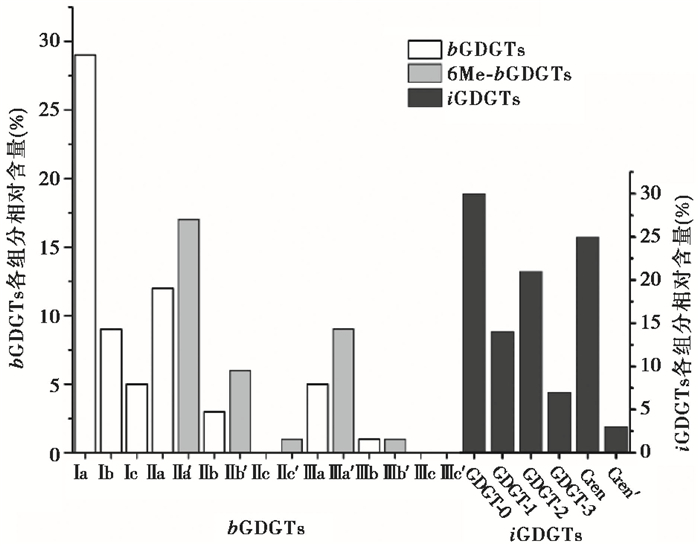
|
图 2 关家山剖面bGDGTs和iGDGTs各组分相对含量图 Ⅰ a~Ⅲ c′相对bGDGTs总含量的百分比;GDGT-0~Cren′相对iGDGTs总含量的百分比;iGDGTs纵坐标间距由bGDGTs纵坐标间距乘以平均Ri/b值确定 Fig. 2 The fractional distributions of bGDGTs and iGDGTs from GJS section. The percentage of Ⅰ a~Ⅲ c′ and GDGT-0~Cren′ are relative to total bGDGTs and iGDGTs, respectively. The interval of Y axis of iGDGTs is adjusted through bGDGTs′ multiplied bythe mean Ri/b value |
关家山剖面重建的古温度MATmr范围从7.3℃到22.3℃;MBT′5ME-MAT范围从-1.9℃到21.3℃(图 3a)。事实上,67%的样点两种指标计算的古温度结果差距在2℃之内,表现出良好的一致性(图 3a)。但是部分样点MBT′5ME-MAT相对离散,甚至低至-1.9℃。因此,本研究采用MATmr进行后续讨论。
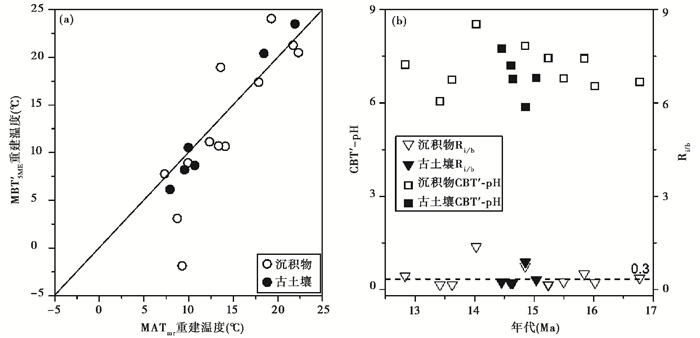
|
图 3 (a) 关家山剖面MATmr和MBT′5ME-MAT以及(b)CBT′-pH和Ri/b指标变化趋势 Fig. 3 (a)The MATmr v.s. MBT′5ME-MAT; (b)CBT′-pH and Ri/b value of GJS section |
关家山剖面的CBT′值在-0.81到0.87之间变化,CBT′-pH值分布在5.9到8.5;Ri/b指标从0.14增加到1.38(图 3b)。5个古土壤样品的CBT′-pH值低于相邻的沉积物,指示相对湿润的环境,与岩相指示的沉积环境一致,说明GDGTs指标在本研究样品中具有适用性。
3 讨论 3.1 关家山剖面GDGTs来源与古温度/古pH值重建可靠性MATmr与MBT′5ME-MAT温度重建函数均建立在土壤样品中,而水体中产生的GDGTs分布与土壤存在差异,因此样品中GDGTs来源极大程度影响了温度重建数据的可靠性[20, 39]。
Sinninghe Damsté等[39]通过对比印度尼西亚Berau三角洲沉积物与全球土壤的Ⅰ/Ⅱ/Ⅲ型bGDGTs分布三角图,发现水生来源或混杂有水生来源bGDGTs样品在三角图上位于土壤样品下方(图 4)。如图 4所示,GJS沉积物多数样品与现代全球土壤bGDGTs分布类似,表明其GDGTs来源以陆源土壤输入为主;虚线椭圆框内3个GJS沉积物样品bGDGTs分布与Berau三角洲类似,表明其来源可能以水体自生为主;矩形框内1个GJS古土壤样品bGDGTs分布介于土壤和水相样品之间,可能其在沉积过程中受到过水体的影响。
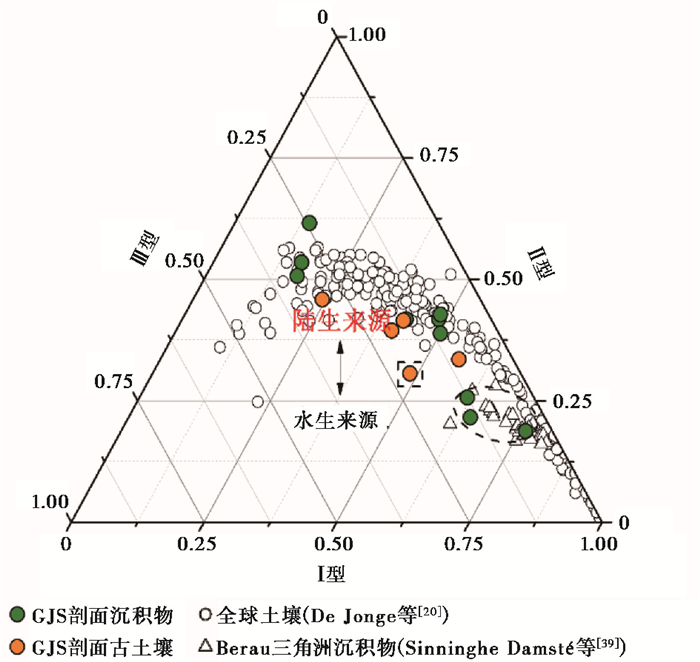
|
图 4 bGDGTs Ⅰ/Ⅱ/Ⅲ型分布三角图 Fig. 4 The ternary diagram of the Ⅰ/Ⅱ/Ⅲ type of bGDGTs |
环数指标#ringstetra(Ⅰ型bGDGT分子的平均环戊烷基数)同样可以用来判断GDGTs是否为陆源输入[39]。现代全球土壤的平均#ringstetra值为0.21±0.19(De Jonge等[20]数据再分析),Berau三角洲沉积物为0.47±0.27,Svalbard海洋沉积物为0.93±0.04(Sinninghe Damsté等[39])。以现代全球土壤值为参考,考虑到标准差,我们认为#ringstetra值高于0.40可能有较大概率混入水相GDGTs(现代全球土壤数据库中仅18.8%高于0.40[18])。为尽可能获得可靠的重建数据,我们综合两种方法严格筛选,GJS样品中共有9个样品可能受到水体自生GDGTs的干扰(表 1)。
| 表 1 关家山样品来源筛选* Table 1 Source selection of the samples from GJS section |
经过筛选后得到的可信MATmr记录了从16.8 Ma(GJS15)到13.4 Ma(GJS2)的持续降温(图 5)。从16.8 Ma到15.0 Ma,MATmr从12.4℃到10.7℃下降约1.7℃,其中,GJS15处在深海氧同位素记录中的中中新世气候适宜期(Middle Miocene Climatic Optimum,简称MMCO)[40~42],然而,在该阶段仅有一个可信的MATmr结果,不能完整捕捉到其响应MMCO事件的特征。从15.0 Ma到13.4 Ma约1.6 Ma内,MATmr从10.7℃到7.3℃急剧下降约3.4℃(图 5)。此阶段,MMCO结束,开始中中新世气候转型(Middle Miocene Climate Transition,简称MMCT),全球温度发生了新生代时期第二次显著的台阶式降温,导致南极冰盖再次扩张且永久性稳定形成[40]。MATmr在该期的连续降温很好地记录了这一气候转型过程。因此,我们认为关家山剖面MATmr记录的16.8~13.4 Ma持续降温过程整体上与该时期全球温度的MMCO期及其后的MMCT台阶式降温事件表现基本一致。这说明西宁盆地古温度变化在该时段显著受到全球温度变化控制。
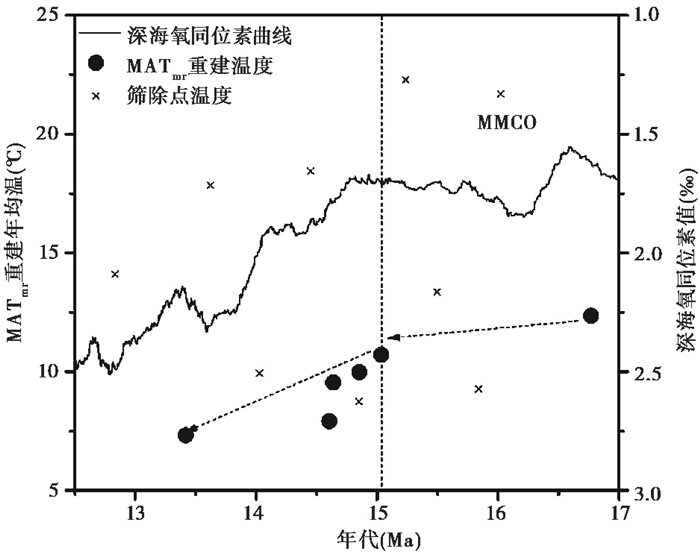
|
图 5 关家山剖面MATmr与深海氧同位素曲线对比[40~41] Fig. 5 MATmr of GJS section and the global deep-sea oxygen isotope record[40~41] |
通常情况下高pH值代表干旱环境,因此,GDGTs的古pH指标曾被用来定性描述赤道非洲地区和黄土-古土壤序列中的的降水变化[19, 43]。陆源输入为主的6个关家山剖面样品GJS2、GJS6、GJS7、GJS9、GJS10和GJS15中(表 1),CBT′-pH值由16.8 Ma的6.67减小至13.4 Ma的6.04,最大值为7.20,平均值为6.56±0.50(图 6),基本维持在中酸性环境。因此,可以认为,尽管西宁盆地16.8 Ma到13.4 Ma间一直处在降温过程中,其仍然维持着相对较为湿润的环境。
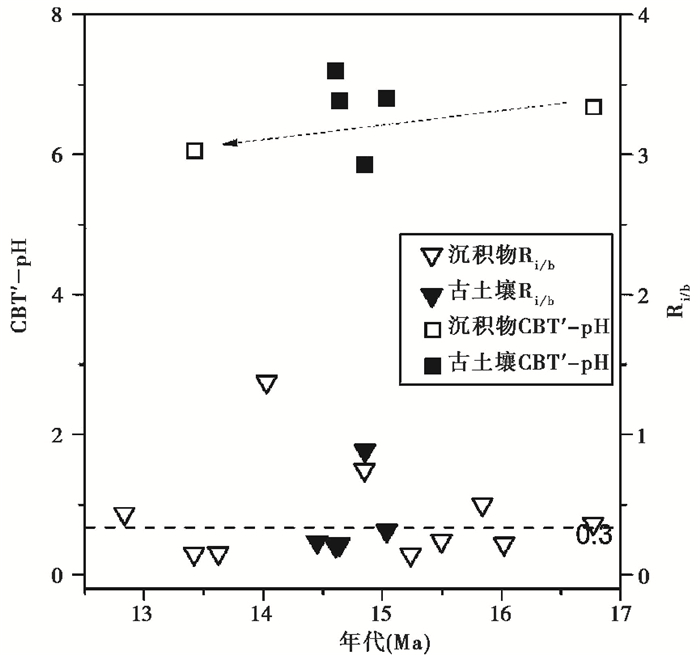
|
图 6 关家山剖面重建pH及Ri/b值 Fig. 6 The paleo-pH and the Ri/b values of GJS section |
pH值和水分条件的改变会改变古菌和细菌群落的相对数量,因而表征iGDGTs和bGDGTs相对含量的Ri/b指标能够响应pH和水分条件的改变[29]。Xie等[29]发现土壤中较大的Ri/b值仅出现在年降水量(MAP)低于600 mm的区域;李婧婧[44]通过对内蒙古新巴尔虎左旗湖泊沉积物的研究发现Ri/b值与水体盐度变化相关,说明该指标的变化序列可能用来解读为区域的干湿变化。由于该研究来自于水体环境,因此,不使用来源筛选的Ri/b序列也具有一定的指示意义。本研究中53%的样品Ri/b值小于0.3,80%的样品Ri/b值小于0.5,指示在16.8 Ma到12.8 Ma间西宁盆地整体处在较为湿润的环境。
事实上,多指标研究均认为西宁盆地及其周边地区在17 Ma至14 Ma左右处于湿润环境,例如:西宁盆地塔山钻孔沉积物岩性和磁化率分析表明,在17~14 Ma期间,沉积物主要为灰白色或青灰色泥岩、泥质粉砂岩和细砂岩,其红度和磁化率值较低[15],与兰州盆地17.1~14.1 Ma沉积序列中沉积物接近[13],表明该阶段西宁盆地河流广泛发育;同时,在这一时期,关家山剖面发育大量古土壤,气候整体上相对湿润。柴达木盆地东北缘怀头他拉剖面沉积物碳酸钙、硫酸根和氯离子含量表明中国西北干旱区中中新世以来气候环境经历了由15.3~13.0 Ma相对湿润转变为13.0~6.6 Ma半干旱-半湿润、最后6.6~1.8 Ma为显著干旱的逐渐阶段性演化过程[45];孢粉记录显示,中新世早期西宁盆地水生植物眼子菜(Potamogetonacidites)大量增加[46],18~14 Ma柴达木盆地喜暖植物占据优势[47],均表明该时期本地区气候相对较湿润;动物化石证据,如咸水河组的草鱼(Ctenopharyn odon)喉齿,表明当时存在有水草丰茂的浅水沼泽[48],反映当时的气候环境湿润,西宁盆地蒋家沟剖面咸水河组上部层位(< 15~18 Ma)湖相沉积地层中首次发现的三趾马和副板齿犀牙齿化石,也证明当时的古植被为代表湿润气候的森林-草原[49];邓涛[50]的研究表明,中国中中新世的哺乳动物群对MMCO的升温事件有敏感的响应,出现了大量喜暖喜湿的哺乳动物,如铲齿象、上猿、河狸、睡鼠、安琪马、爪兽、库班猪、利齿猪和古麟等。中中新世的铲齿象动物群反映了相当暖湿的气候环境;柴达木盆地东、中西部地区爪兽化石的新发现也指示出中中新世晚期至晚中新世早期,湿润和多树的古环境[51]。
在整体的湿润环境背景下,Ri/b指标同时记录到了两次干旱事件,分别发生于14.0 Ma和14.8 Ma左右。其中最显著的干旱事件发生在14.0 Ma,正值MMCO结束,全球进入MMCT的长期变冷时期[52]。14 Ma左右的干旱化加剧事件在青藏高原东北部的西宁盆地[53]和循环盆地[54]均有记录。鹿化煜等[53]研究西宁盆地的河流阶地发现,风尘堆积从14 Ma开始,指示亚洲干旱化的重要发展;Xu等[54]在循化盆地获得的孢粉记录也表明14.0~12.5 Ma为灌木-草原植被混合的干冷气候。值得注意的是,尽管14.8 Ma左右古土壤和沉积物两个样品中(GJS8和GJS9)(表 1和图 6)的Ri/b值均相对较高(分别为0.75和0.88),指示偏干的气候,同期CBT′重建的pH值(GJS8为5.9,GJS9数据不可靠)却相对较低(图 6)。两种指标的不同步现象可能是因为pH值和降水量或盐度之间不总是同步变化,当然,也有能是由于某一指标记录出现偏差所造成。因此,14.8 Ma是否指示了干旱事件无法确定。这也说明我们对GDGTs指标的行为模式仍存在疑问,有待于进一步研究。
3.4 GDGTs重建青藏高原东北部古环境的问题及潜力GJS2和GJS6的MATmr计算温度低至7.3℃和7.9℃,接近甚至低于西宁盆地现代盆地中心MAT(如西宁市,7.9~8.1℃),而在13.4 Ma后,全球温度仍在持续下降[40~42]。可能的解释有3种:一是西宁盆地又经历了区域性的升温过程,然后降温至现代MAT;二是沉积物记录到的温度为当时的流域平均温度,因此可以认为当时流域平均MAT接近现今盆地中心MAT;三是MATmr重建的温度可能存在系统偏低,因为不同区域环境微生物响应过程不一致,全球转换函数可能无法有效记录本地绝对温度。因此,在应用GDGTs指标精确定量重建地质历史时期古温度时仍存在困难,需要进一步区分并改进不同区域和环境古温度重建模式,并不断挖掘新指标。当然,西宁盆地中中新世GDGTs古环境恢复的尝试研究,证明该生物标志物代用指标在青藏高原东北部新近纪早期乃至更早时期的地层中仍具有很大的应用潜力。
4 结论本研究通过青藏高原东北部西宁盆地关家山(GJS)剖面中中新世连续地层中微生物细胞膜脂的生物标志化合物GDGTs分布和代用指标研究,探讨西宁盆地在全球变化背景下的古温度、古pH值和古水文等记录的区域环境变化特征及驱动机制,评估GDGTs指标在该区域较老地层中的应用潜力。通过分析沉积物样品在bGDGTsⅠ/Ⅱ/Ⅲ型分布三角图中的位置及其沉积物来源分析,我们排除受到水体自生GDGTs干扰的古土壤样品后,选用陆源输入的样品GDGTs计算古温度。发现MATmr记录了关家山剖面16.8 Ma到13.4 Ma的持续降温,从16.8 Ma到13.4 Ma期间温度从12.4℃到7.3℃下降约5.1℃,关家山剖面MATmr记录的16.8~13.4 Ma持续降温过程整体上与该时期全球温度的MMCO期及其后的MMCT台阶式降温事件表现基本一致。说明西宁盆地古温度在中中新世显著受全球温度变化控制。CBT′-pH值平均为6.56±0.50,且80%样点干旱指标Ri/b值小于0.5,表明西宁盆地在16.8 Ma到12.8 Ma之间整体处于较为湿润的环境;但在14.0 Ma和14.8 Ma,Ri/b值记录了两次干旱事件,其中最为显著的14.0 Ma干旱事件可能响应MMCT的快速变冷,与以往沉积物岩性和磁化率、孢粉和动物化石等其他指标的研究结果基本一致。总之,虽然在古温度绝对值计算等问题上仍存在一定困难,GDGTs展现了在西宁盆地乃至青藏高原东北部在新近纪早期甚至更老地层中应用的潜力。
致谢 样品分析在中国科学院青藏高原研究所大陆碰撞与高原隆升重点实验室完成。感谢青藏高原环境变化与地表过程重点实验室高少鹏老师帮助测定GDGTs;感谢孟庆泉和方小辉以及杨戎生、吕爽、阮笑白、谢宇龙、毛子强、卢胜城在野外采样中提供的帮助;感谢编辑杨美芳老师和评审人提出的宝贵建议。
| 1 |
Boos W R, Kuang Z M. Dominant control of the South Asian monsoon by orographic insulation versus plateau heating. Nature, 2010, 463(7278): 218-222. DOI:10.1038/nature08707 |
| 2 |
Ding L, Xu Q, Yue Y H et al. The Andean-type Gangdese Mountains:Paleoelevation record from the Paleocene-Eocene Linzhou Basin. Earth and Planetary Science Letters, 2014, 392: 250-264. DOI:10.1016/j.epsl.2014.01.045 |
| 3 |
Ding S, Xu Y, Wang Y et al. Distribution of branched glycerol dialkyl glycerol tetraethers in surface soils of the Qinghai-Tibetan Plateau:Implications of brGDGTs-based proxies in cold and dry regions. Biogeosciences, 2015, 12(11): 3141-3151. DOI:10.5194/bg-12-3141-2015 |
| 4 |
Liu W G, Liu Z H, An Z S et al. Late Miocene episodic lakes in the arid Tarim Basin, Western China. Proceeding of National Academic Sciences of the United States of America, 2014, 111(46): 16292-16296. DOI:10.1073/pnas.1410890111 |
| 5 |
Ruddiman W F, Kutzbach J E. Forcing of Late Cenozoic Northern Hemisphere climate by plateau uplift in Southern Asia and the American West. Journal of Geophysical Research Atmospheres, 1989, 94(15): 18409-18427. |
| 6 |
Sun B, Wang Y F, Li C S et al. Early Miocene elevation in northern Tibet estimated by palaeobotanical evidence. Scientific Reports, 2015, 5(5): 10379. |
| 7 |
李吉均, 方小敏. 青藏高原隆起与环境变化研究. 科学通报, 1998, 43(15): 1568-1574. Li Jijun, Fang Xiaomin. The research of Tibetan Plateau uplift and environment change. Chinese Science Bulletin, 1998, 43(15): 1568-1574. |
| 8 |
Xu Q, Ding L, Zhang L Y et al. Paleogene high elevations in the Qiangtang Terrane, central Tibetan Plateau. Earth and Planetary Science Letters, 2013, 362(1): 31-42. |
| 9 |
Bai Y, Fang X M, Gleixner G et al. Effect of precipitation regime on δD values of soil n-alkanes from elevation gradients-Implications for the study of paleo-elevation. Organic Geochemistry, 2011, 42(7): 838-845. DOI:10.1016/j.orggeochem.2011.03.019 |
| 10 |
Dupont-Nivet G, Krijgsman W, Langereis C G et al. Tibetan Plateau aridification linked to global cooling at the Eocene-Oligocene transition. Nature, 2007, 445(7128): 635-638. DOI:10.1038/nature05516 |
| 11 |
Hoorn C, Straathof J, Abels H A et al. A Late Eocene palynological record of climate change and Tibetan Plateau uplift (Xining Basin, China). Palaeogeography, Palaeoclimatology, Palaeoecology, 2012, 344-345(8): 16-38. |
| 12 |
Bosboom R E, Abels H A, Hoorn C et al. Aridification in continental Asia after the Middle Eocene Climatic Optimum (MECO). Earth and Planetary Science Letters, 2014, 389(1): 34-42. |
| 13 |
Zhang Y B, Sun D H, Li Z J et al. Cenozoic record of aeolian sediment accumulation and aridification from Lanzhou, China, driven by Tibetan Plateau uplift and global climate. Global and Planetary Change, 2014, 120(3): 1-15. |
| 14 |
Fang X M, Zan J B, Appel E et al. An Eocene-Miocene continuous rock magnetic record from the sediments in the Xining Basin, NW China:Indication for Cenozoic persistent drying driven by global cooling and Tibetan Plateau uplift. Geophysical Journal International, 2015, 201(1): 78-89. DOI:10.1093/gji/ggv002 |
| 15 |
Zan J B, Fang X M, Yan M D et al. Lithologic and rock magnetic evidence for the Mid-Miocene Climatic Optimum recorded in the sedimentary archive of the Xining Basin, NE Tibetan Plateau. Palaeogeography, Palaeoclimatology, Palaeoecology, 2015, 431: 6-14. DOI:10.1016/j.palaeo.2015.04.024 |
| 16 |
Schouten S, Hopmans E C, Sinninghe Damsté J S. The organic geochemistry of glycerol dialkyl glycerol tetraether lipids:A review. Organic Geochemistry, 2013, 54(1): 19-61. |
| 17 |
王欢业, 刘卫国, 张传伦等. 青海湖钻孔沉积物中的羟基甘油二烷基甘油四醚类化合物及其环境意义. 第四纪研究, 2017, 37(5): 1151-1160. Wang Huanye, Liu Weiguo, Zhang Chuanlun et al. Hydroxylated glycerol dialkyl glycerol tetraethers in Lake Qinghai sediments and their paleoclimate implications. Quaternary Sciences, 2017, 37(5): 1151-1160. |
| 18 |
李奇缘, 刘潇敏, 王章章等. 青藏高原东部现代泥炭GDGTs分布特征及环境意义. 第四纪研究, 2016, 36(2): 388-395. Li Qiyuan, Liu Xiaomin, Wang Zhangzhang et al. Distributions and environmental significance of GDGTs in modern peat samples from eastern Tibetan Plateau. Quaternary Sciences, 2016, 36(2): 388-395. |
| 19 |
Weijers J W H, Schouten S, van den Donker J C et al. Environmental controls on bacterial tetraether membrane lipid distribution in soils. Geochimica et Cosmochimica Acta, 2007, 71(3): 703-713. DOI:10.1016/j.gca.2006.10.003 |
| 20 |
De Jonge C, Hopmans E C, Zell C I et al. Occurrence and abundance of 6-methyl branched glycerol dialkyl glycerol tetraethers in soils:Implications for palaeoclimate reconstruction. Geochimica et Cosmochimica Acta, 2014, 141: 97-112. DOI:10.1016/j.gca.2014.06.013 |
| 21 |
Dang X Y, Yang H, Naafs B D A et al. Evidence of moisture control on the methylation of branched glycerol dialkyl glycerol tetraethers in semi-arid and arid soils. Geochimica et Cosmochimica Acta, 2016, 189: 24-36. DOI:10.1016/j.gca.2016.06.004 |
| 22 |
Ding S, Schwab V F, Ueberschaar N et al. Identification of novel 7-methyl and cyclopentanyl branched glycerol dialkyl glycerol tetraethers in lake sediments. Organic Geochemistry, 2016, 102: 52-58. DOI:10.1016/j.orggeochem.2016.09.009 |
| 23 |
Liu W G, Wang H Y, Zhang C L et al. Distribution of glycerol dialkyl glycerol tetraether lipids along an altitudinal transect on Mt. Xiangpi, NE Qinghai-Tibetan Plateau, China. Organic Geochemistry, 2013, 57(4): 76-83. |
| 24 |
Li J J, Pancost R D, Naafs B D A et al. Distribution of glycerol dialkyl glycerol tetraether (GDGT) lipids in a hypersaline lake system. Organic Geochemistry, 2016, 99: 113-124. DOI:10.1016/j.orggeochem.2016.06.007 |
| 25 |
Sun C J, Zhang C L, Li F Y et al. Distribution of branched glycerol dialkyl glycerol tetraethers in soils on the Northeastern Qinghai-Tibetan Plateau and possible production by nitrite-reducing bacteria. Science China:Earth Sciences, 2016, 59(9): 1834-1846. DOI:10.1007/s11430-015-0230-2 |
| 26 |
Wang H, Liu W, Zhang C L et al. Assessing the ratio of archaeol to caldarchaeol as a salinity proxy in highland lakes on the northeastern Qinghai-Tibetan Plateau. Organic Geochemistry, 2013, 54(3): 69-77. |
| 27 |
Wang H, Liu W, Zhang C L et al. Branched and isoprenoid tetraether(BIT) index traces water content along two marsh-soil transects surrounding Lake Qinghai:Implications for paleo-humidity variation. Organic Geochemistry, 2013, 59(2): 75-81. |
| 28 |
Wang H, Liu W, Zhang C L et al. Distribution of glycerol dialkyl glycerol tetraethers in surface sediments of Lake Qinghai and surrounding soil. Organic Geochemistry, 2012, 47(6): 78-87. |
| 29 |
Xie S C, Pancost R D, Chen L et al. Microbial lipid records of highly alkaline deposits and enhanced aridity associated with significant uplift of the Tibetan Plateau in the Late Miocene. Geology, 2012, 40(4): 291-294. DOI:10.1130/G32570.1 |
| 30 |
DeCelles P G, Castaneda I S, Carrapa B et al. Oligocene-Miocene Great Lakes in the India-Asia collision zone. Basin Research, 2016, 26: 1-20. DOI:10.1111/bre.12217 |
| 31 |
李小玲. 浅析西宁市生态环境质量评价. 青海环境, 2004, 14(3): 128-130. Li Xiaoling. Analysis of the ecological environment quality evaluation in Xining. Journal of Qinghai Environment, 2004, 14(3): 128-130. |
| 32 |
严焕德. 西宁盆地末次冰期晚冰阶古气候变化的黄土记录[D]. 重庆: 西南大学硕士毕业论文, 2007: 7-8. Yan Huande. Paleoclimatic Change During Late Stadial of the Last Glaciation Based on Loess from Xining Basin[D]. Chongqing: The Dissertation Submitted to Southwest University for the Master Degree, 2007: 7-8. http://cdmd.cnki.com.cn/Article/CDMD-10635-2007131143.htm |
| 33 |
Zhang W L, Zhang T, Song C H et al. Termination of fluvial-alluvial sedimentation in the Xining Basin, NE Tibetan Plateau, and its subsequent geomorphic evolution. Geomorphology, 2017, 297: 86-99. DOI:10.1016/j.geomorph.2017.09.008 |
| 34 |
Dai S, Fang X M, Guillaume D N et al. Magnetostratigraphy of Cenozoic sediments from the Xining Basin:Tectonic implications for the northeastern Tibetan Plateau. Journal of Geophysical Research:Solid Earth, 2006, 111(B11): 335-360. |
| 35 |
Nieto-Moreno V, Rohrmann A, van der Meer M T J et al. Elevation-dependent changes in n-alkane δD and soil GDGTs across the South Central Andes. Earth and Planetary Science Letters, 2016, 453: 234-242. DOI:10.1016/j.epsl.2016.07.049 |
| 36 |
Wang C, Hren M T, Hoke G D et al. Soil n-alkane δD and glycerol dialkyl glycerol tetraether(GDGT) distributions along an altitudinal transect from Southwest China:Evaluating organic molecular proxies for paleoclimate and paleoelevation. Organic Geochemistry, 2017, 107: 21-32. DOI:10.1016/j.orggeochem.2017.01.006 |
| 37 |
Inglis G N, Collinson M E, Riegel W et al. Mid-latitude continental temperatures through the Early Eocene in Western Europe. Earth and Planetary Science Letters, 2017, 460: 86-96. DOI:10.1016/j.epsl.2016.12.009 |
| 38 |
Naafs B D A, Gallego-Sala A V, Inglis G N et al. Refining the global branched glycerol dialkyl glycerol tetraether(brGDGT) soil temperature calibration. Organic Geochemistry, 2017, 106: 48-56. DOI:10.1016/j.orggeochem.2017.01.009 |
| 39 |
Sinninghe Damsté J S. Spatial heterogeneity of sources of branched tetraethers in shelf systems:The geochemistry of tetraethers in the Berau River delta (Kalimantan, Indonesia). Geochimica et Cosmochimica Acta, 2016, 186: 13-31. DOI:10.1016/j.gca.2016.04.033 |
| 40 |
Zachos J, Pagani M, Sloan L et al. Trends, rhythms, and aberrations in global climate 65 Ma to present. Science, 2001, 292(5517): 686-693. DOI:10.1126/science.1059412 |
| 41 |
Zachos J C, Dickens G R, Zeebe R E. An Early Cenozoic perspective on greenhouse warming and carbon-cycle dynamics. Nature, 2008, 451(17): 279-283. |
| 42 |
Miller K G, Fairbanks R G, Mountain G S. Tertiary oxygen isotope synthesis, sea level history, and continental margin erosion. Paleoceanography, 1987, 2(1): 1-19. DOI:10.1029/PA002i001p00001 |
| 43 |
Peterse F, Mertinez-Garcia A, Zhou B et al. Molecular records of continental air temperature and monsoon precipitation variability in East Asia spanning the past 130, 000 years. Quaternary Science Reviews, 2014, 83(1): 76-82. |
| 44 |
李婧婧. 不同盐度湖泊微生物脂类分布特征及其环境意义[D]. 武汉: 中国地质大学博士学位论文, 2014: 44-46. Li Jingjing. Distribution and Significance of Microbial Lipids in Lakes along A Salinity Gradient[D]. Wuhan: The Dissertation Submitted to China University of Geosciences for the Doctor Degree, 2014: 44-46. http://cdmd.cnki.com.cn/Article/CDMD-10491-1015661035.htm |
| 45 |
应红, 宋春晖, 鲍晶等. 柴达木盆地东北缘中中新世以来古气候变化. 第四纪研究, 2016, 36(4): 847-858. Ying Hong, Song Chunhui, Bao Jing et al. Paleoclimate change since the Middle Miocene in the northeastern Qaidam Basin. Quaternary Sciences, 2016, 36(4): 847-858. |
| 46 |
魏明建, 王成善, 万晓樵等. 第三纪青藏高原面高程与古植被变迁. 现代地质, 1998, 12(3): 318-326. Wei Mingjian, Wang Chengshan, Wan Xiaoqiao et al. Variation history of height and vegetation of the Tibet Plateau in Tertitary. Journal of Graduate School, 1998, 12(3): 318-326. |
| 47 |
Miao Y F, Fang X M, Herrmann M et al. Miocene pollen record of KC-1 core in the Qaidam Basin, NE Tibetan Plateau and implications for evolution of the East Asian monsoon. Palaeogeography, Palaeoclimatology, Palaeoecology, 2011, 299(1-2): 30-38. DOI:10.1016/j.palaeo.2010.10.026 |
| 48 |
李传夔, 邱铸鼎, 王士阶. 青海西宁盆地中新世地层及哺乳动物群性质. 古脊椎动物与古人类, 1981, 19(4): 21-28. Li Chuankui, Qiu Zhuding, Wang Shijie. Discussion on Miocene stratigraphy and mammals from Xining Basin, Qinghai. Vertebrata PalAsiatica, 1981, 19(4): 21-28. |
| 49 |
韩建恩, 邵兆刚, 陈麒光等. 青海西宁盆地三趾马、副板齿犀化石的发现及意义. 地球科学, 2015, 36(1): 115-120. Han Jian'en, Shao Zhaogang, Chen Qiguang et al. Discovery and significance of Hipparion and Parelasmotherium fossils in the Xining Basin, Qinghai Province. Acta Geoscientica Sinica, 2015, 36(1): 115-120. |
| 50 |
邓涛. 中国北方哺乳动物群在中中新世气候适宜期的记录和表现. 第四纪研究, 2016, 36(4): 810-819. Deng Tao. Records and characteristics of the mammalian faunas of Northern China in the Middle Miocene Climatic Optimum. Quaternary Sciences, 2016, 36(4): 810-819. |
| 51 |
陈少坤, 李强, 王晓鸣. 柴达木盆地晚中新世早期的爪兽化石及其古环境意义. 第四纪研究, 2015, 35(3): 528-538. Chen Shaokun, Li Qiang, Wang Xiaoming. Chalicothere fossils from the early Late Miocene of the Qaidam Basin, and their paleoenvironmental implications. Quaternary Sciences, 2015, 35(3): 528-538. |
| 52 |
Flower B P, Kennett J P. The Middle Miocene climatic transition:East Antarctic ice sheet development, deep ocean circulation and global carbon cycling. Palaeogeography, Palaeoclimatology, Palaeoecology, 1994, 108(94): 537-555. |
| 53 |
鹿化煜, 安芷生, 王晓勇等. 最近14 Ma青藏高原东北缘阶段性隆升的地貌证据. 中国科学(D辑), 2004, 34(9): 855-864. Lu Huayu, An Zhisheng, Wang Xiaoyong et al. Geomorphologic evidence of phased uplift of the northeastern Qinghai-Tibet Plateau since 14 million years ago. Science in China(Series D):Earth Sciences, 2004, 34(9): 855-864. |
| 54 |
Xu Z L, Zhang J Y, Ji J L et al. The mid-Miocene pollen record of the Xunhua Basin, NE Tibetan Plateau:Implications for global climate change. Acta Geologica Sinica, 2015, 89(5): 1649-1663. DOI:10.1111/acgs.2015.89.issue-5 |
2 Key Laboratory of Continental Collision and Plateau Uplift, Institute of Tibetan Plateau Research, Chinese Academy of Sciences, Beijing 100101;
3 University of Chinese Academy of Sciences, Beijing 100049)
Abstract
The MATmr records of Glycerol Dialkyl Glycerol Tetraether lipids (GDGTs) from Guanjiashan section (36°40.55'N, 101°50.24'E), Xining Basin, NE Tibetan Plateau, suggest the continuous cooling between 16.8 Ma and 13.4 Ma (droping in temperature about 5.1℃). Our result is consistent with the climatic events responding to Middle Miocene Climate Optimum (MMCO)and Middle Miocene Climate Transition (MMCT)recorded by global deep-sea oxygen isotope records. Thus, it reveals that MATmr were controlled by global temperature change during this period. The mean value of CBT'-derived paleo-pH (CBT'-pH)values is 6.56±0.50, and the abundances of bGDGTs (branched GDGTs)relative to that of archaeal isoprenoidal (iso)GDGTs (Ri/b, as a drought proxy in Chinese soils)for 80% samples are less than 0.5, together indicating relatively humid in that period as a whole in the Xining Basin. But two drought events were recorded by Ri/b values in 14.0 Ma and 14.8 Ma. Although it's difficult to estimate the absolute paleo-temperature at present, GDGTs have important potentiality to reconstruct paleo-temperature of Xining Basin, and so far as to NE Tibetan Plateau since Neogene and even older sediments. 2018, Vol.38
2018, Vol.38

